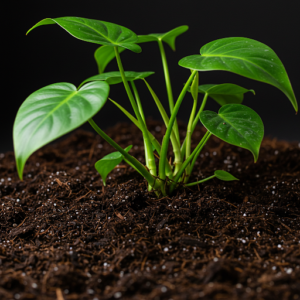We often gaze upon lush green fields or towering forests and marvel at the visible signs of life. But beneath our feet lies an equally vital ecosystem, a complex and dynamic world teeming with life – the soil. Often overlooked, healthy soil is not just dirt; it’s the foundation upon which our food systems, climate stability, and the very fabric of biodiversity depend. Neglecting its health comes at a steep price, threatening the future of our planet and our well-being.
Food Security: A Harvest Rooted in Healthy Soil
The most direct link between soil health and human survival lies in food security. Healthy soil is the bedrock of productive agriculture. It provides essential nutrients, water retention, and aeration that plants need to thrive.
Nutrient Cycling: A vibrant soil ecosystem, teeming with microorganisms, breaks down organic matter and makes essential nutrients like nitrogen, phosphorus, and potassium available to plants in usable forms. This natural fertilization reduces the reliance on synthetic fertilizers, which can have detrimental environmental impacts.
Water Management: Healthy soil, rich in organic matter, acts like a sponge, absorbing and retaining rainwater. This improves water availability for crops during dry periods, reducing the need for irrigation and making agriculture more resilient to drought. Conversely, good soil structure allows for better drainage, preventing waterlogging and root diseases.
Disease Suppression: A balanced soil microbiome can suppress soil-borne diseases and pests, reducing the need for chemical pesticides. This not only protects the environment but also ensures healthier and safer food for consumers.
Improved Yields and Nutritional Value: Plants grown in healthy soil are generally more robust and productive, leading to higher yields. Furthermore, they tend to have a higher nutritional content, providing us with more wholesome food.
When soil is degraded through practices like intensive tillage, monocropping, and excessive chemical use, its ability to perform these vital functions diminishes. This leads to decreased yields, increased reliance on costly and environmentally damaging inputs, and ultimately threatens our ability to feed a growing global population.
Climate Change: The Soil’s Dual Role as Sink and Source
The relationship between soil health and climate change is complex but crucial. Healthy soil plays a significant role in both mitigating and adapting to the impacts of a changing climate.
Carbon Sequestration: Soil is a massive natural carbon sink, storing more carbon than the atmosphere and all terrestrial vegetation combined. Practices that enhance soil health, such as cover cropping, no-till farming, and agroforestry, can significantly increase the amount of carbon sequestered in the soil as organic matter. This removes greenhouse gases from the atmosphere, helping to mitigate climate change.
Reduced Greenhouse Gas Emissions: Degraded soils can become a source of greenhouse gas emissions. Intensive tillage can release stored carbon dioxide into the atmosphere, while waterlogged and poorly aerated soils can emit methane and nitrous oxide, potent greenhouse gases. Healthy soil management minimizes these emissions.
Enhanced Resilience to Climate Extremes: As mentioned earlier, healthy soil’s water retention capacity helps crops withstand droughts. Its improved structure also makes it more resilient to heavy rainfall and erosion, which are becoming increasingly frequent due to climate change. This resilience is crucial for maintaining food production in the face of more volatile weather patterns.
Ignoring soil health in the context of climate change is a critical oversight. Embracing practices that nurture our soils, we can unlock their potential as a powerful tool in the fight against global warming and build more resilient agricultural systems.
Biodiversity: A Thriving Ecosystem Beneath Our Feet
The soil is not just an inert medium; it’s a vibrant ecosystem teeming with billions of microorganisms, fungi, insects, and other invertebrates. This incredible biodiversity is essential for maintaining soil health and supporting the life above ground.
Decomposition and Nutrient Cycling: Soil organisms break down organic matter, releasing nutrients that plants need to grow. Different organisms play specific roles in this complex process, ensuring a continuous supply of essential elements.
Soil Structure Formation: The activity of soil organisms, along with the presence of organic matter, helps to create a stable soil structure with good aeration and water infiltration.
Pest and Disease Control: A diverse soil microbiome can naturally suppress harmful pests and diseases, reducing the need for chemical interventions that can harm beneficial organisms.
Supporting Above-Ground Biodiversity: Healthy soil provides the foundation for thriving plant communities, which in turn support a wide range of animal life. Degraded soils lead to reduced plant diversity and can have cascading negative effects on entire ecosystems.
Intensive agricultural practices, deforestation, and pollution can severely disrupt soil biodiversity, leading to a decline in soil health and the services it provides. Protecting and enhancing soil biodiversity is crucial not only for maintaining healthy soil but also for safeguarding the broader biodiversity of our planet.
Conclusion: Investing in the Unseen for a Sustainable Future
Soil health is not a niche environmental concern; it is a fundamental pillar of food security, climate change mitigation, and biodiversity conservation. Recognizing the vital role of this often-unseen resource is crucial for building a sustainable future. By adopting practices that nurture and protect our soils – from regenerative agriculture to responsible land management – we can ensure a secure food supply, mitigate the impacts of climate change, and safeguard the rich biodiversity that makes our planet thrive. The health of the soil is inextricably linked to our own health and the health of the planet. It’s time we started treating it with the respect and attention it deserves.




